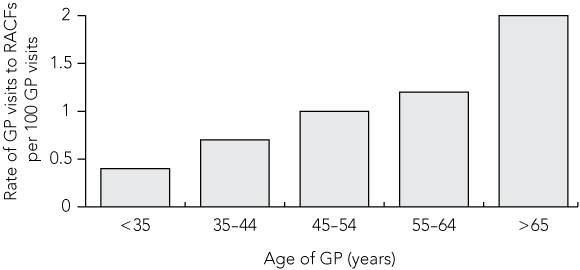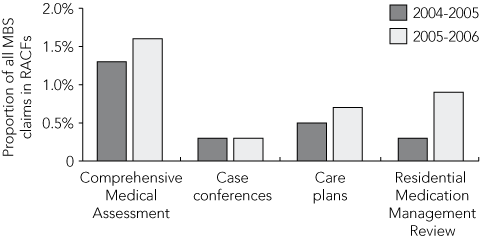The importance of aged care is growing substantially with the increase in the number of older people in our society. This trend will continue, with the number of people aged ≥ 85 years projected to increase from 1.5% of the population in 2004 to 6%–8% by 2051.1 Along with an increase in the number of elderly people in Australian society, there has been a steady increase in the number of people living in residential aged-care facilities (RACFs). At 30 June 2005, an estimated 7.3% of people aged ≥ 70 years were living as permanent residents in RACFs.2 Although nurses and personal care attendants provide 24-hour supportive care to residents of RACFs, general practitioners are the main providers of primary medical care. The current primary care medical model leaves the medical care of each resident to his or her independent GP, who, in many cases, will not have formal links with the RACF.3 The purpose of our article is to review the current status of GP clinical activity in RACFs and the impact of current initiatives to enhance access by RACF residents to these services.
Data extracted from Medicare Benefits Schedule (MBS) statistics for the financial year 2005–064 indicate that the predominant service provided by GPs to residents of RACFs is a standard consultation. Standard, after-hours and public-holiday consultations together comprise 96.5% of all medical services provided in RACFs (Box 1). The remaining items comprise services related to Medicare rebates that have been progressively introduced by the Australian Government to facilitate better access to GP services as part of its Enhanced Primary Care (EPC) program.
Medicare data show that between 2000 and 2005 there was an increase in the provision of complex services to patients in RACFs. For example, complex consultations of Level D (items 51 and 96) increased by 67%. There has also been an 18% increase in the number of all services provided per GP since 2000.5,6 In 2005–06, an average of 12.8 GP services were provided per occupied aged-care bed, amounting to an average cost to Medicare of $570 per occupied bed per year. This is substantially higher than the average of 4.5 non-specialist services per whole patient equivalent in 2005–06,7 with expenditure of $239 per patient in 2005–06.8
There is a growing concern reflected in the literature that GP services to RACFs are inadequate to meet current needs. A 2004 survey of GP availability in RACFs found that 52% of RACFs sometimes had difficulty obtaining GP services for existing residents, and 56% sometimes had difficulty obtaining GP input for routine services such as writing and reviewing medication charts and prescriptions.9
We identified the following barriers to provision of GP services to RACFs:
Low levels of reimbursement. GPs perceive that the level of reimbursement for their services to RACFs is lower than for routine clinical work in their surgeries.10,11
Time-consuming processes. Increased demands on GPs — with the paperwork required for RACF residents12 and, quite often, unnecessary and time-consuming transposition of clinical data — make visits to RACFs time-consuming and leave GPs with little time for contact with the patients themselves.
Younger GPs have much lower rates of providing services to RACFs than older GPs. RACFs are becoming increasingly reliant on an established cohort of older, predominantly male GPs who themselves may soon be reaching retirement age (Box 2).6,13
The Aged Care GP Panels Initiative seeks to increase the number of GP services for RACFs and to encourage younger GPs to work in the area of residential aged care.14,15 The initiative was introduced in July 2004. A review after 12 months of operation showed that 58% of aged-care homes in Australia were participating in the initiative at 1 July 2005.5 Progress during the first year of operation of the initiative was good, with the number of participating GPs increasing by 59% in the second half of the year compared with the first half. The number of aged-care services provided also increased by 5.4% over this period. In the 2007–08 federal budget, additional funding for the initiative was announced.16
The EPC MBS program was introduced in November 1999. It provided new Medicare items to increase the financial incentives for greater GP involvement in RACF care: Comprehensive Medical Assessment (CMA), multidisciplinary case conferences, GP contribution to care plans, and Residential Medication Management Review. A 2003 evaluation of the uptake of EPC items relating to RACFs found that CMA items were the most commonly claimed.17 GPs found care plans to be complex, involving a considerable amount of paperwork and time to review medical notes and test results. They also found organising case conferences to be very time-consuming and poorly remunerated for the effort involved,17 despite the evidence that conferences can be effective.18,19 There was a small increase in the number of EPC Medicare claims from 2004–05 to 2005–06, with the exception of the item relating to case conferences (Box 3). Further increases in the number of care plans could be expected with recent improved remuneration for the item relating to GP contribution to care plans.16
Recognising that a substantial proportion (over a third) of permanent residents will die within a year after admission to an RACF,2 a range of innovative palliative care programs has been developed as part of the National Palliative Care Program. These include guidelines for a palliative approach designed for staff (including GPs) working in or with RACFs.20,21 However, participation of GPs in advanced care planning in RACFs remains limited because of a lack of financial incentives, the time required, and difficulty in advising patients about the treatment they may require in advance of need.22
1 Medicare services provided by general practitioners to residents of RACFs in the financial year 2005–064
- Svetla Gadzhanova1
- Richard Reed2
- Department of General Practice, Flinders University, Adelaide, SA.
Our study was supported by a Flinders Medical Centre Foundation Project Grant 2006–2007.
None identified.
- 1. Australian Bureau of Statistics. Population projections, Australia, 2004–2101. Canberra: ABS, 2006. (ABS Cat. No. 3222.0.) http://www.abs. gov.au/AUSSTATS/abs@.nsf/DetailsPage/3222.02004%20to% 202101?OpenDocument (accessed Jan 2007).
- 2. Australian Institute of Health and Welfare. Residential aged care in Australia 2004–05: a statistical overview. Canberra: AIHW, 2006. (AIHW Cat. No. AGE 45.) http://www.aihw.gov.au/publications/index.cfm/title/10303 (accessed Jun 2007).
- 3. Australian Society for Geriatric Medicine. Position statement No. 9. Medical care for people in residential aged care services. Sydney: ASGM, 2001. http://www.asgm.org.au/pdfdocs/position_statements/PositionStatementNo09.pdf (accessed Jun 2007).
- 4. Medicare Australia. Health care providers. Health statistics. http://www.medicareaustralia.gov.au/providers/health_statistics/index.shtml (accessed Oct 2006).
- 5. Australian Government Department of Health and Ageing. Aged Care General Practice Panels Initiative. Report on the review of the initiative. Canberra: DoHA, 2006. http://www.health.gov.au/internet/wcms/publishing.nsf/Content/pcd-programs-acgppi-12monthreview (accessed Jun 2007).
- 6. Lewis GA, Pegram RW. Residential aged care and general practice: workforce demographic trends, 1984–2000. Med J Aust 2002; 177: 84-86. <MJA full text>
- 7. Britt H, Miller GC, Charles J, et al. General practice activity in Australia 2005–06. Canberra: Australian Institute of Health and Welfare, 2007. (AIHW Cat. No. GEP 19.) http://www.aihw.gov.au/publications/index.cfm/title/10377/ (accessed Jun 2007).
- 8. Steering Committee for the Review of Government Service Provision. Report on government services 2007. Canberra: Productivity Commission, 2007. http://www.pc.gov.au/gsp/reports/rogs/2007/index.html (accessed Jun 2007).
- 9. Australian Government Department of Health and Ageing. Aged Care GP Panels Initiative. 2004 aged care homes survey. Canberra: DoHA, 2005. http://www.health.gov.au/internet/wcms/publishing.nsf/Content/pcd-programs-acgppi-homessurvey (accessed Jun 2007).
- 10. Australian Medical Workforce Advisory Committee. The general practice workforce in Australia: supply and requirements to 2013. Sydney: AMWAC, 2005. http://www.health.nsw.gov.au/amwac/pdf/gp_2005.pdf (accessed Jun 2007).
- 11. Australian Medical Association and Royal Australian College of General Practitioners. GP services to residential aged care facilities. Canberra: AMA, 2006. http://www.ama.com.au/web.nsf/doc/WEEN-6VT8LA/$file/GP_Services_to_Residential_Aged_Care_Facilities.pdf (accessed Jun 2007).
- 12. Siggins Miller Consultants and School of Population Health, University of Queensland. A report to the Brisbane North Division of General Practice (BNDGP). The residential care project. Brisbane: BNDGP, 2002.
- 13. Charles J, Britt H, Valenti L. The independent effect of age of general practitioner on clinical practice. Med J Aust 2006; 185: 105-109. <MJA full text>
- 14. Australian Government Department of Health and Ageing. Aged Care GP Panels Initiative — statement of rationale for Divisions performance indicators. Canberra: DoHA, 2004. http://www.health.gov.au/internet/wcms/Publishing.nsf/Content/health-medicare-health_pro-gp-rationale.htm (accessed Jun 2007).
- 15. Australian Government Department of Health and Ageing. The Aged Care GP Panels Initiative. Fact sheet for GPs. Canberra: DoHA, 2004. http://www.health.gov.au/internet/wcms/publishing.nsf/Content/EAF9AFB5716D60BDCA25703F000D4559/$File/factsheet.pdf (accessed Jun 2007).
- 16. Australian Government Department of Health and Ageing. Aged care — improved health services for residents of aged care homes. Budget 2007–2008. Canberra: DoHA, 2007. http://www.health.gov.au/internet/budget/publishing.nsf/Content/budget2007-afact13.htm (accessed May 2007).
- 17. Wilkinson D, Mott K, Morey S, et al. Evaluation of the Enhanced Primary Care (EPC) Medicare Benefits Schedule (MBS) items and the General Practice Education, Support and Community Linkages Program (GPECSL) — final report. Canberra: Australian Government Department of Health and Ageing, 2003.
- 18. King M, Roberts M. Multidisciplinary case conference reviews: improving outcomes for nursing home residents, carers and health professionals. Pharm World Sci 2001; 23: 41-45.
- 19. Crotty M, Halbert J, Rowett D, et al. An outreach geriatric medication advisory service in residential aged care: a randomised controlled trial of case conferencing. Age Ageing 2004; 33: 612-617.
- 20. Australian Government Department of Health and Ageing. Guidelines for a palliative approach in residential aged care. Enhanced version. Canberra: DoHA, 2006. http://www.health.gov.au/internet/wcms/publishing.nsf/Content/1CADF13B80E96F4BCA256FFE0077FC62/$File/guideall.pdf (accessed Jun 2007).
- 21. Australian Government Department of Health and Ageing. Education, training and support for general practitioners in palliative care. Canberra: DoHA, 2004. http://www.health.gov.au/internet/wcms/publishing.nsf/Content/palliativecare-pubs-workf-educat.htm (accessed Jun 2007).
- 22. Brown M. Participating in end of life decisions. The role of general practitioners. Aust Fam Physician 2002; 31: 60-62.







Abstract
We conducted a literature review to assess the current status of general practitioner services in residential aged-care facilities (RACFs) in Australia and the impact of recent initiatives to enhance access by RACF residents to these services.
Of 400 publications identified, 22 were selected as relevant to our study. We also analysed publicly available statistical data on GP services in RACFs.
Recent initiatives to improve quality of care and facilitate access to GP services for RACF residents include the Aged Care GP Panels Initiative, the Enhanced Primary Care program, and an expanded role of palliative care.
Despite these initiatives, many GPs still find RACF services unappealing due to a perceived poor level of remuneration for the effort involved.
Further improvements in access to and quality of GP services to RACFs may require new models of care delivery and financing.